The Giza Plateau in Egypt
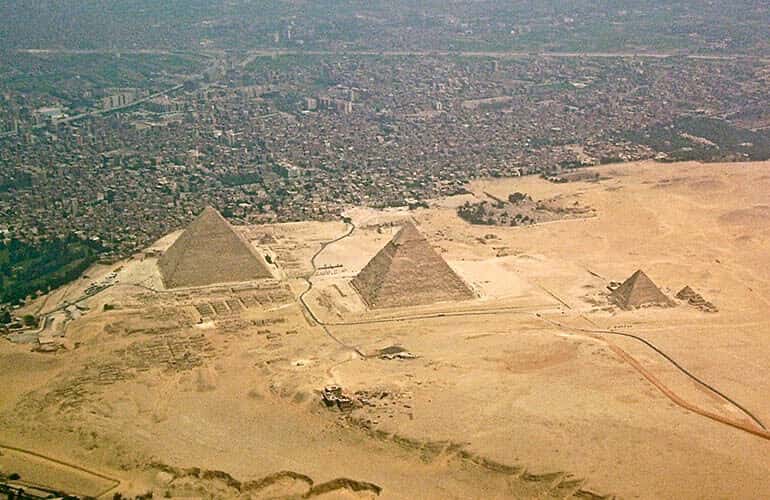
Giza Plateau: Nearly 5,000 years ago, Giza became the royal burial ground (necropolis) for Memphis, capital of Egypt. In less than 100 years, the ancient Egyptians built the three pyramid complexes to serve as the tombs for their dead kings.
After the king’s death, his body was brought by boat to the valley temple for preparation before being taken up the causeway and buried under, and in some cases within, the pyramid.
The mortuary temples were maintained for many years afterward with priests making daily offerings to the dead god-king.
The king’s close family and the royal court were buried in satellite pyramids and stone tombs called mastaba nearby, seeking to share in the king’s power in death, as they had in life.
Tomb of Khentkawes
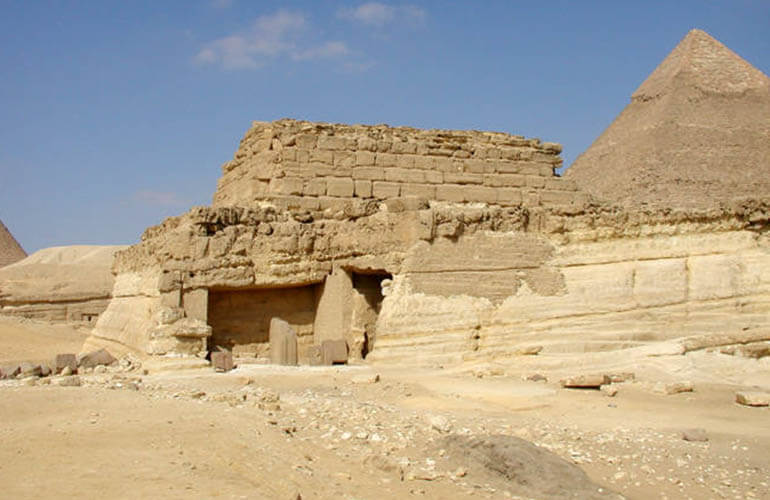
This was the last major tomb built at Giza. Queen Khentkawes, daughter of Menkaure, probably gave birth to a new dynasty that moved its necropolis to Abu Sir.
Pyramids of Giza
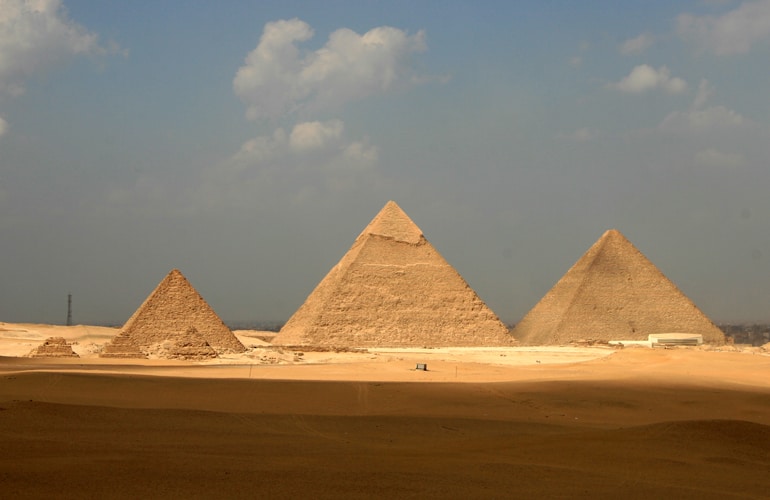
Three successive generations built these monumental structures during the 4th Dynasty of the Old Kingdom (2686-2181 BC).
The name of Giza is known as the area where about 4600 years ago, were built the three great pyramids of the Fourth Dynasty of Egypt. Giza is part of the great necropolis of Memphis, which stretched for more than 40 kilometers, Each of the three great pyramids had its own name, which also designated the surrounding cemetery. The horizon of Khufu, Khafra is great and Menkaure. During the reign of Cheops, it was when the plateau of Gizeh reaches its great relevance.
The pyramids that surrounded the remains of the pharaohs were part of large funeral complexes, including temples and other tombs, including small pyramids. To the east of the pyramid of Cheops, the so-called queens’ pyramids were built, which are three small pyramids of almost 50 meters on each side and 30 meters high, to serve as a tomb for his mother Hetepheres and his wives Meritites and Henutsen. In the year 1992, another pyramid was discovered located at the southeast of the Great Pyramid, with a square base of 23 meters on each side and a little more than 12 meters high with only the remains of the first three stone rows.
Giza Plateau Reconstruction
The funerary complex included the main pyramid, covered in white limestone, various satellite pyramids and a mortuary temple joined by a causeway to a valley temple.
The Great Pyramid

The oldest and largest of the pyramids were built by the 4th-Dynasty Khufu (2589-66BC).
The Pyramid of Khufu, also known as the Great Pyramid, is aligned with two others: the pyramids of Khafre and Menkaure.
One of the 7 wonders of the work of the Ancient World, the Great
Pyramid of Giza is the only one still standing. Moreover, it was the tallest building in the world for thousands of years
Khufu had the biggest pyramid and the smallest statue Although the Great Pyramid of Giza is the largest, the smallest statue found of a pharaoh belongs to Khufu. It’s only three inches long and made of ivory.
A solar boat was also found there
At the base of the pyramid, a big hole was found with an unarmed boat, which was later assembled and preserved in a museum. On the stones that covered the hole was found the name Djedefre, son and heir of Cheops, who probably put the boat there.
There are three chambers inside the pyramid
The king’s chamber, the queen’s chamber and the never-finished chamber are the three places inside it. However, experts say that there is a fourth space under the queen’s chamber which is where Cheops was actually buried. Others think that Khufu was never really in the pyramid.
Pyramids of Khafre
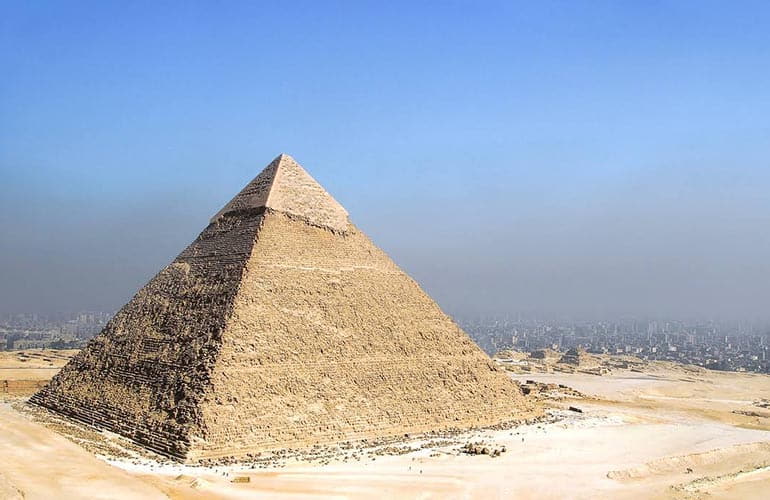
While Khafre’s Pyramid is nearly as grand as that of his father, Khufu, the Pyramid of Menkaure, Khafre’s successor, is much smaller, hinting perhaps at a decline in power and commitment or simply a change in priorities.
For years, the pyramid of Khafrewas considered as “The Great Pyramid” since it was believed to be bigger than the one of Cheops, but it was only a visual effect since it is located at a higher point in the plateau.
However, the old belief that it was bigger is now a reality. The erosion of the summit of the pyramid of Cheops and the preservation of part of the limestone cover of the pyramid of Kephren, which can be seen clearly today, make the latter higher.
The original height of the pyramid of Kephren is 143.49 meters, while that of Cheops does not exceed 139.
The construction of the pyramid of Kephren was ordered by the Pharaoh himself, to who have also attributed the constructions of The Great Sphinx, the Temple of the Valley, a funerary temple and a road of 500 meters long that communicates his pyramid with his temple.
Pyramids of Menkaure
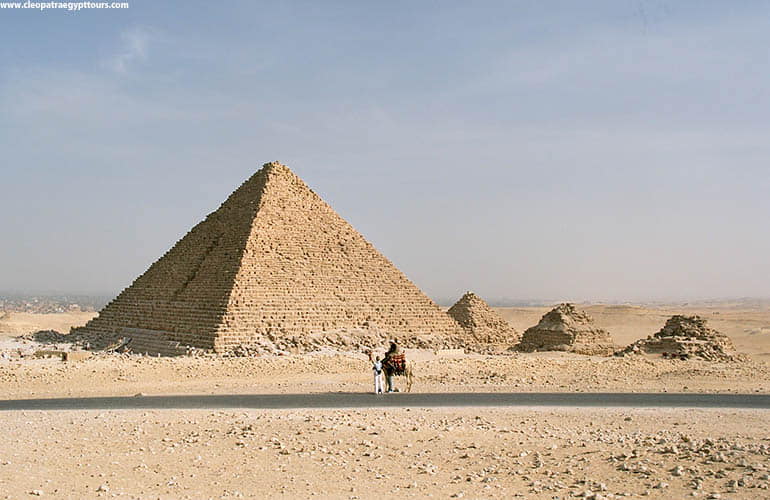
Pyramid of Menkaure. Officially called the Pyramid of Menkaure, it is the smallest of the three pyramids on the Giza plateau. Known in its time as the “Divine Pyramid”, it was part of the funeral complex along with the three queens’ pyramids, a funeral temple, the valley temple and a professional roadway linking the two temples.
At present, the pyramid is devoid of almost all its covering, and we can observe the regular threads that make up its core. The only thing that remains is the granite part, located at the base. On the north side of the building, the pyramid has an opening apparently made by man.
The Sphinx
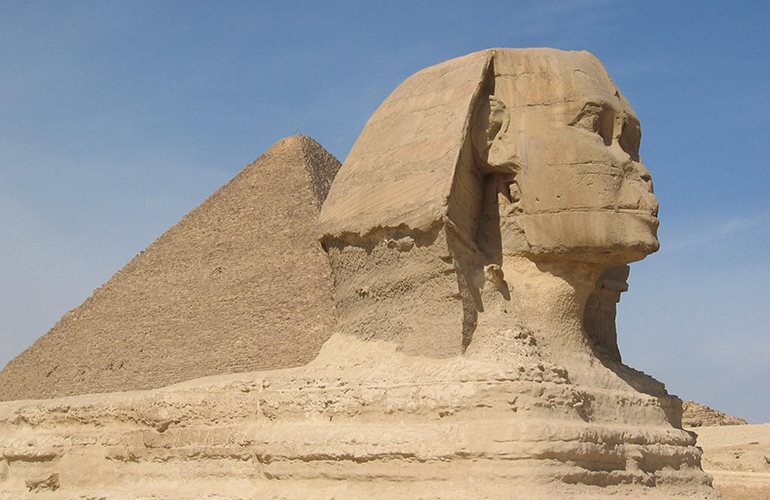
Guardian of the Giza Plateau, the leonine Sphinx is known to the Arabs as Abu al-Hol, the “father of terror”.
The Great Sphinx of Giza is one of the most emblematic sculptures in the world… So much so, that it’s instantly associated with everything related to ancient Egypt. The iconic monument, as you may know, is made up of a mythological creature with the body of a reclining lion and the head of a person, more specifically that of King Kephren of Egypt’s 4th Dynasty.
The monumental structure is located on the west bank of the Nile River in the city of Giza. Egyptologists believe it was part of king Khafre burial complex during the 4th Dynasty, but other scholars claim that the Great Sphinx is much more than a place to hold the “essence” of a king for eternity. Some historians claim that it could be a huge library, but these theories have been disproved and discarded by countless researches.
But what did the original appearance of the Great Sphinx of Giza look like? It is clear that over the past 4500 years, climate and erosion have affected the appearance of the monumental sculpture. It is also truly amazing that after so long, the oldest statue in the world still stands and retains all its essence.
The original sphinx was very different from the one we know today. Although it is now composed of the same color as its sandy surroundings, the huge monument could have been covered by a colorful layer that was preserved for centuries.
In the past, the sphinx had a long braided beard and a nose, but recently it was discovered that it was painted red, blue and yellow. However, there is another theory about its original appearance: the Great Sphinx of Giza could have been a lion, which would explain the enormous disproportions of the statue. If we consider that the ancient Egyptians were true lovers of symmetry, the disproportion between the small head and the enormous body suggests that the head of King Khafre was sculpted above that of a lion.
The solar boat (Khufu Ship)
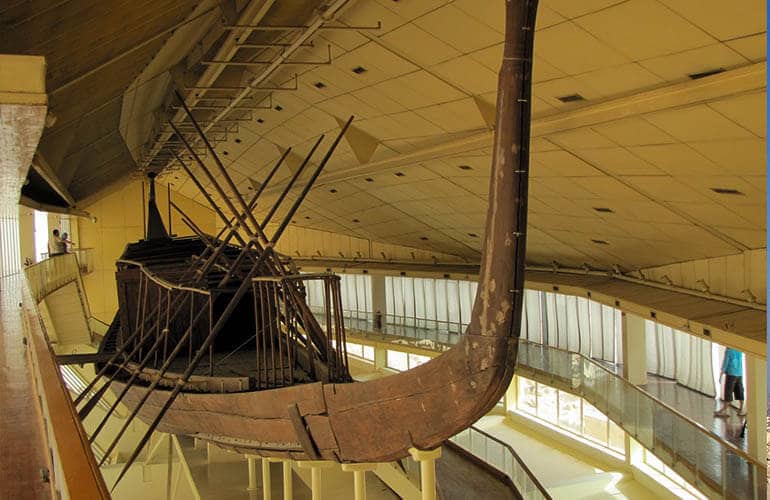
The solar boat was discovered in 1950 when architect and archaeologist Kamal El-Mallakh was serving as inspector of antiquities at Giza. It was he who noticed a thin line of mortar outlining long narrow shafts on the south side of the Great Pyramid of Khufu.
At that time the area was destined to be a tourist route, so when the workers dug it out they discovered large blocks of limestone, which caught the attention of Kamal El-Mallakh who insisted that they be thoroughly investigated.
in 1954, the team began digging and under the slabs, they discovered a large boat that had been dismantled, with its oars and everything in a remarkable state of preservation. The find had been hermetically preserved and arranged in thirteen carefully stacked layers, tied with ropes and pieces of matting.
In 1958 the reconstruction of the ship began by Ahmed Youssef Mustafa, the main restorer of the Antiquities Service. The specialist had to reassemble 1224 pieces of cedar, acacia, and other woods as a puzzle but without even a picture of the whole work.
The reconstruction of the work took approximately 10 years and was completely assembled in 1968. No nails were used for the construction, the ship was assembled by a system of sewing with vegetable fiber ropes through holes because when the wood swells in the water, the ropes are tightened and do not allow the wood to enter the ship.
The solar boat is 43.3m long and 5.9m wide and can carry approximately 45 tons. It has a central cabin with panels 9m long, another open one and a small one at the head of the boat that surely belonged to the captain.
The boat was steered by five pairs of oars, plus a pair at the stern that did the work of the rudder. In this site, you can see drawings of papyrus carved as a representation of the type of boat used throughout the history of ancient Egypt.
At present, the specific function for which the boat was created is under discussion. In the texts discovered in the pyramids it is discovered that when the pharaoh dies, his soul goes up to heaven in the solar boat to join his father Ra. The stipulation is whether this boat was created to be part of the deceased’s, or whether it was used in the funeral procession to move the king’s body down the river to his pyramid complex.
Although other wooden frames have been discovered in Egypt, the solar boat of Cheops remains the most spectacular and striking of all those found so far.
It is currently on display in a museum near the Great Pyramid of Giza, so it is a visit more than.
The valley temple
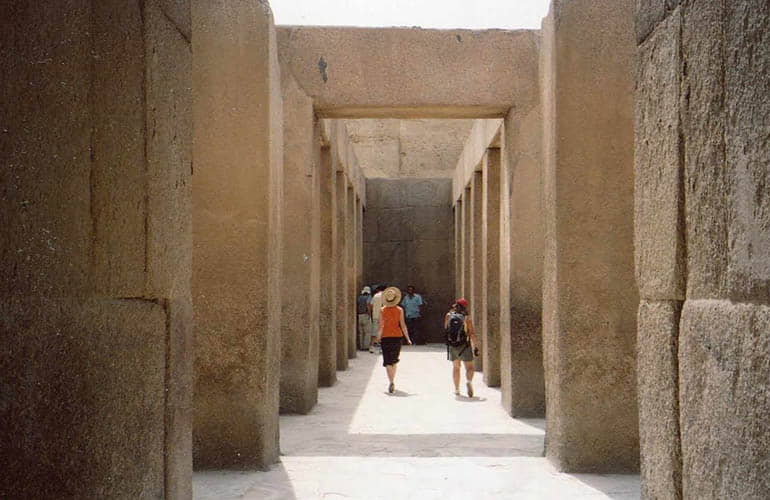
The Valley Temple of the Khafre on the Giza plateau is one of the most fascinating ancient structures on earth. It features supermassive blocks of stone, some of which exceed 150 tons in weight.
Besides that, the incredible “twisted” stones inside are another detail that has caused confusion and admiration among experts and tourists alike.
the valley temple is One of the most famous in Egypt is undoubtedly the one belonging to Khafre, located on the Giza plateau, just 500 meters from the pyramid of Khafre and in close proximity to the Great Sphinx.
It turns out to be one of the best-preserved ancient temples in Egypt, surviving thousands of years almost intact because it was covered with sand until the 19th century.
The limestone walls of the temple measure 45 m and their thickness decrease exponentially, giving it an exterior appearance of a mastaba.
The walls are covered with polished red granite both inside and outside, while the floor is made of white limestone.
It is believed that the temple served both the process of mummification of the Pharaoh and his purification before being buried in the pyramid.
The entrances are flanked by the sphinx, and the roof of the structure is supported by columns also made of red granite.
It is devoid of paintings and inscriptions and has openings at the top of the walls that provide natural light.
The interior was adorned with statues of the pharaoh, which were placed in an existing well later than the one built.
All of them are very deteriorated, except one which was made out of diorite and now stored in the Egyptian Museum in Cairo.
The temple itself is considered an absolute marvel of ancient engineering for a number of reasons.
Its distinctive architectural style makes it one of the oldest and best-preserved buildings in Egypt.
These mesmerizing engineering skills have allowed the mortar-free face to remain in position for thousands of years after the temple was built.
One of the main features of the valley temple at Giza is the huge amount of megalithic stones used in its construction. The central structure of the valley temple is one of its most unusual features: its entire construction of massive limestone blocks exceeds 100 to 150 tons in weight (each).
It remains a complete mystery as to how the ancient builders managed to transport and lift these massive stones to heights of over 40 feet.
MEANING OF THE GIZA PYRAMIDS
Archaeologists agree that pyramids served as monumental structures for the burial of kings. They were topped with gold-covered pyramidions (pyramid-shaped capstones) which caught the first rays of the sun and their shape perhaps symbolized the mythical, primeval mound of creation.
However, because the exact purpose of some of the rooms and shafts of the Giza Pyramids is unknown, the fact that some air shafts point towards important constellations, that the southeast corners lie on a near-perfect diagonal and that their sides align with true north inspires many to look hard for fanciful explanations.
However, such alignments are simply consistent with ancient Egyptian funerary beliefs that the king’s soul would rise up to join the “eternal stars”.
Book your Travel Package now to know more about Egypt history.






